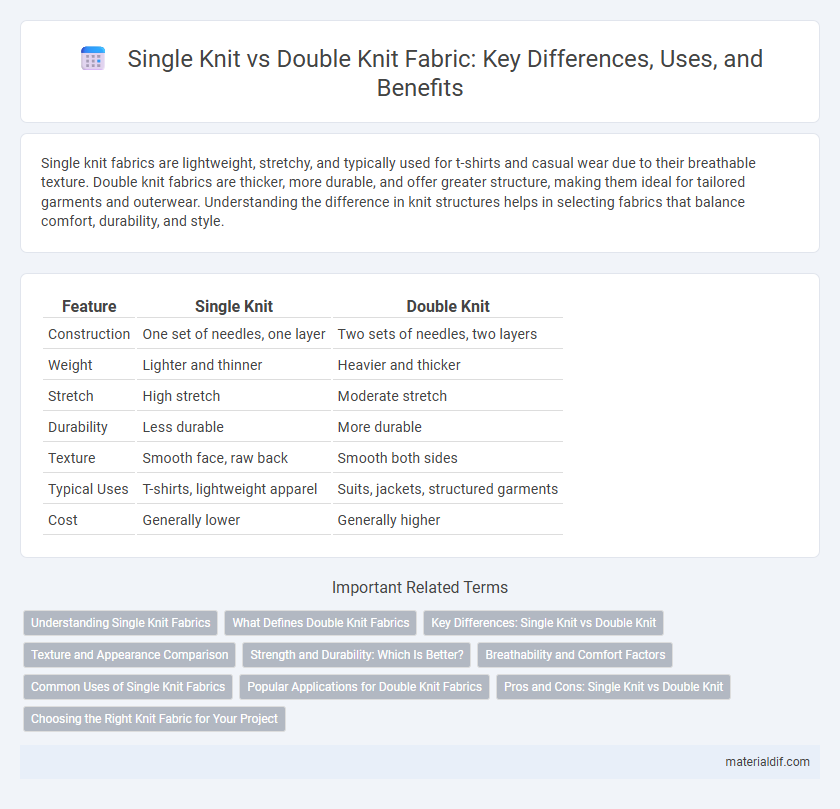Single knit fabrics are lightweight, stretchy, and typically used for t-shirts and casual wear due to their breathable texture. Double knit fabrics are thicker, more durable, and offer greater structure, making them ideal for tailored garments and outerwear. Understanding the difference in knit structures helps in selecting fabrics that balance comfort, durability, and style.
Table of Comparison
| Feature | Single Knit | Double Knit |
|---|---|---|
| Construction | One set of needles, one layer | Two sets of needles, two layers |
| Weight | Lighter and thinner | Heavier and thicker |
| Stretch | High stretch | Moderate stretch |
| Durability | Less durable | More durable |
| Texture | Smooth face, raw back | Smooth both sides |
| Typical Uses | T-shirts, lightweight apparel | Suits, jackets, structured garments |
| Cost | Generally lower | Generally higher |
Understanding Single Knit Fabrics
Single knit fabrics feature a construction with one set of needles that creates a smooth face and a textured back, making them lightweight and breathable. Commonly used in t-shirts, single knit fabrics offer good stretch and drape, enhancing comfort and fit. Their simple structure results in less durability compared to double knit, but they excel in softness and ease of care.
What Defines Double Knit Fabrics
Double knit fabrics are defined by their construction, featuring two sets of needles that create two interlocked layers, resulting in a thicker, more durable, and reversible material compared to single knit. This structure provides enhanced elasticity, stability, and resistance to curling at the edges, making double knit fabrics ideal for structured garments and activewear. Their dense, smooth surface supports vibrant printing and maintains shape better over time than single knit fabrics.
Key Differences: Single Knit vs Double Knit
Single knit fabric features a single set of needles, creating a lightweight, stretchy material with a smooth face and a slightly textured back, ideal for t-shirts and casual wear. Double knit fabric uses two sets of needles, producing a thicker, more durable, and reversible textile with less stretch, commonly found in suits, dresses, and structured garments. Key differences include weight, stretchability, texture, and durability, with single knits offering breathability and comfort, while double knits provide stability and shape retention.
Texture and Appearance Comparison
Single knit fabric features a smooth, flat texture on the front with a noticeable vertical rib pattern on the back, resulting in a lightweight, stretchy material ideal for t-shirts and casual wear. Double knit fabric has a more structured and thicker texture with identical appearance on both sides, offering a firmer hand feel and better durability suitable for activewear and dresses. The double knit's balanced, dense construction reduces curling at the edges compared to the single knit's tendency to roll, enhancing its shape retention in finished garments.
Strength and Durability: Which Is Better?
Double knit fabric offers superior strength and durability compared to single knit due to its construction, which involves two layers of interlocked loops, making it thicker and more resilient. Single knit fabric, while softer and more flexible, is more prone to stretching and wear over time because of its single-layer structure. For applications requiring long-lasting performance and resistance to distortion, double knit is the better choice.
Breathability and Comfort Factors
Single knit fabrics feature a lighter, more porous construction that enhances breathability, making them ideal for warm-weather clothing. Double knit fabrics, denser and thicker due to their interlocked loops, provide greater insulation and durability but can compromise airflow and moisture-wicking capabilities. Comfort factors favor single knits for their softer hand feel and flexibility, while double knits offer structure and warmth suitable for cooler climates.
Common Uses of Single Knit Fabrics
Single knit fabrics are commonly used in T-shirts, lightweight sweaters, and casual wear due to their soft texture and excellent stretchability. This fabric type provides breathability and flexibility, making it ideal for athleisure and everyday clothing. Single knit is also preferred in baby garments and undergarments because of its comfort and ease of movement.
Popular Applications for Double Knit Fabrics
Double knit fabrics are widely used in activewear, casual dresses, and tailored garments due to their durable structure and excellent stretch recovery. These fabrics provide warmth and insulation, making them popular in sweaters and cardigans. Their thicker, heavier texture also suits upholstery and home decor items where resilience and shape retention are essential.
Pros and Cons: Single Knit vs Double Knit
Single knit fabric offers lightweight breathability and greater stretch, making it ideal for casual wear and activewear, but it tends to be less durable and can easily lose shape over time. Double knit fabric provides enhanced durability, thicker texture, and better insulation, which suits structured garments and cold-weather apparel, yet it is heavier and less flexible than single knit. Choosing between single knit and double knit depends on balancing comfort, durability, and garment purpose.
Choosing the Right Knit Fabric for Your Project
Single knit fabric features a lightweight, stretchable structure ideal for t-shirts and casual wear, offering breathability and comfort. Double knit fabric provides a thicker, more durable texture with less stretch, making it suitable for structured garments like blazers and skirts. Selecting between single and double knit depends on your project's requirements for flexibility, warmth, and garment shape retention.
Single knit vs Double knit Infographic

 materialdif.com
materialdif.com